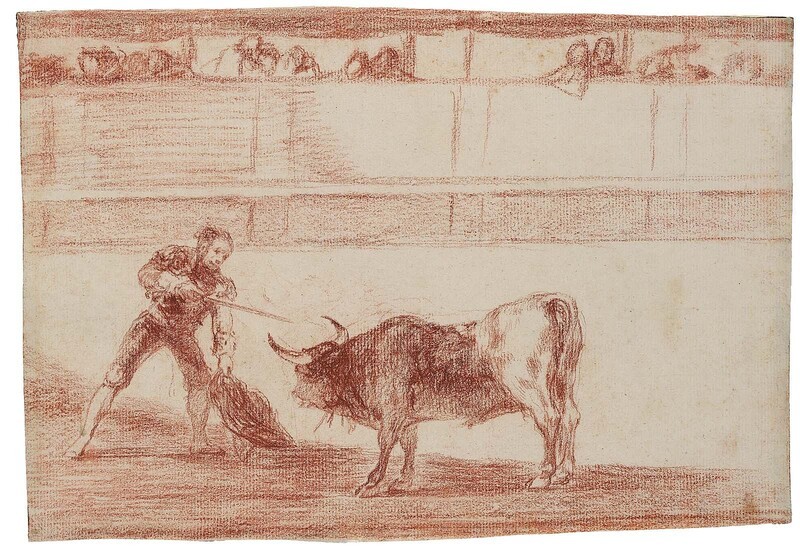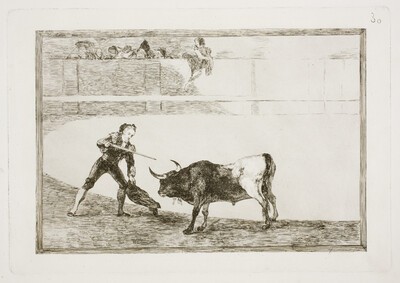- Cronología
- Ca. 1814 - 1816
- Ubicación
- Museum of Fine Arts, Boston, Boston, United States
- Dimensiones
- 195 x 287 mm
- Técnica y soporte
- Sanguine on laid paper
- Reconocimiento de la autoría de Goya
- Undisputed work
- Titular
- Museum of Fine Arts, Boston
- Ficha: realización/revisión
- 03 Oct 2021 / 22 Jun 2023
- Inventario
- (1973.696)
- Otros títulos:
-
See How the ancient Spaniards hunted bulls on horseback in the countryside.
After leaving Spain in the mid-19th century this drawing belonged to Eugene Loizelet, Paris, and later to Paul Lefort, and was auctioned at the liquidation of the latter's estate on 28-29 January 1869 at the Hôtel Drouot in Paris (lot 123). It then passed into the hands of Sophie Jay in Frankfurt. It then belonged to the Colnaghi Gallery in London, and was acquired in 1931 by the American collector Philip Hofer of Cambridge, Massachusetts. He sold it in 1974, through the dealer R. M. Light, to the Museum of Fine Arts, Boston, which acquired it with funds donated by the Frederick J. Kennedy Memorial Foundation. It entered the museum on 12 June 1974. It is one of the few drawings of bullfighting and its extensions that does not belong to the collection of the Museo Nacional del Prado in Madrid.
See How the ancient Spaniards hunted bulls on horseback in the countryside.
Preparatory drawing for the print Pedro Romero killing a standing bull. We see Pedro Romero (1754-1839), the famous bullfighter of Goya's time, about to kill the bull, with the posture of the moment. The bullfighter and the bull are seen in profile. The light is concentrated on the right two-thirds of the scene, illuminating most of the visible part of the bullring and more than half of the barrier, which is slightly drawn.
Goya's use of light isolates the matador and the bull at the critical moment of killing the latter. Their postures are contrasting. The drawing is sober, as is the moment depicted, but it is faithful to what was seen in the bullrings of the time, as Pedro Romero's way of bullfighting was very austere.
Although what is depicted in this preparatory study was transferred by Goya quite faithfully to the copper plate and therefore to the print, except for the audience behind the barrier, which was reduced and concentrated in the left half of it, authors such as Lafuente Ferrari consider the engraving to be much more successful.
-
Goya: Order and disorderMuseum of Fine ArtsBoston2014
-
1946pp. 177-216, espec. pp. 204-205
-
ParísLe Club Français du Livre1963p. 128
-
Vie et ouvre de Francisco de GoyaParísOffice du livre1970p. 279, cat. 1211
-
Barcelona1974p. 17
-
The Changing image: Prints by Francisco GoyaBostonMuseum of Fine Arts1974pp. 236-239, cat. 188-191
-
Dibujos de Goya, 2 volsBarcelonaNoguer1975pp. 394-395, cat. 272
-
MadridMuseo Nacional del Prado2001pp. 91-93

